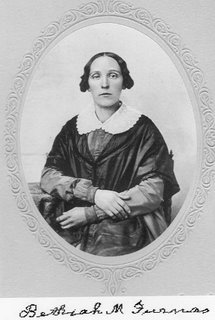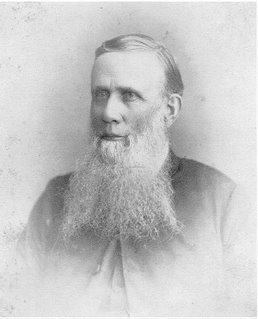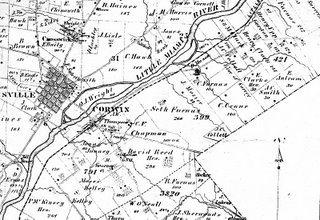John Harvey ~ Farmer and Poet
and his first wife
LYDIA BALLARD
November 9th, 1800 ~ November 13th, 1832 in Harveysburg, Ohio
And his second wife
MAHALA PLUMMER
June 14th, 1814 in Highland Co., Ohio ~ December 30th, 1862 in Pleasant Plain, Iowa
With Lydia Ballard:
1. JAMES HARVEY, b: July 1st, 1822 ~ Jan 15th, 1894, moved to Iowa (m. Minerva)[iv].
2. MARY ANN HARVEY, b: October 18th, 1823
3. ELIAS HARVEY, b: June 10th, 1825 ~ September 16th, 1842 (buried in Warren Co., Ohio)
4. MARTHA HARVEY, b: January 27th, 1827
5. EUNICE HARVEY, b: February 2nd, 1829
6. JOHN M. HARVEY, b: February 22nd, 1831 (moved to Iowa)
With Mahala Plummer:
1. LYDIA ANN HARVEY, b: August 21st, 1835
2. EMILY HARVEY, b: January 22nd, 1838
3. CAROLINE HARVEY, b: December 5th, 1839
4. ELI P. HARVEY, b: January 1st, 1842 ~ February 16th, 1842 (buried in Warren Co., Ohio)
5. ABI HARVEY, b: January 19th, 1843 ~ August 4, 1844 (Buried in Warren Co., Ohio)
6. ALFRED HARVEY, b: August 14th, 1845 ~ October 26th, 1845 (buried in Warren Co., Ohio)
7. JOSEPH HARVEY, b: March 20th, 1847 ~May 22nd, 1853 (buried in Warren Co., Ohio)
8. OLIVER HARVEY, b: March 11th, 1850
9. WILLIAM A. HARVEY, b: JULY 11, 1851 ~ January 6th, 1853 (buried in Warren Co., Ohio)
10. CHARLES HARVEY, b: February 15th, 1853 ~ February 15th, 1853 (buried in Warren Co., Ohio)
John Harvey settled in Harveysburg, Ohio in Warren Co., Ohio. He authored a book of poetry entitled Miscellaneous Poems; Moral, Religious, and Sentimental (Cincinnati: Published by James Harvey, 1848). The first poem in this book is entitled:
A SKETCH OF THE AUTHOR’S LIFE
I came into being, as the record shows,
When the eighteenth century was just at its close;
From North Carolina, the land of my birth,
I came with my parents, to this part of the earth,
(Ohio, renown’d as a free and rich state)
In the spring of one thousand eight hundred and eight.
This country was chiefly a wilderness then,
And in many places the abode of red men,
From the graves of their fathers now driven far west,
By men of pale faces, who loved themselves best.
On the banks of Todd’s Fork, about twenty-three years,
My days pass’d in pleasure unmingled with tears;
A loving companion, ten years of the time,
Was still the chief blessing of my early prime,
My dearest relations were all yet alive,
And most of them able to work and to thrive;
When half a dozen miles to the westward I went (to Harveysburg),
And settled where the rest of my life has been spent,
Where sorrow and care have attended my lot,
While scenes of past pleasure could not be forgot.
My faithful companion was the first one that died (Lydia Ballard),
Of all to whom I was most tenderly tied;
“But all of my losses and causes of care
Have, in my poor scribbling, been stated elsewhere.
And, oh! May I never repine at the rod~
I still have been follw’d by the mercies of God!
And while, by his blessing, upon a rich soil,
I still have been reaping the fruits of my toil,
A second companion has help’d me along (Mahala Plummer),
And lighten’d the burden of many a song.
John Harvey wrote poetry about his sorrows: the death of his first wife Lydia whom he had met in 1819 while coming home from Waynesville on the hill above Corwin after attending Miami Quarterly Meeting in the White Brick Meetinghouse and the tragic death of his infant son, Elias P.
Lydia Harvey’s gravestone located in the Quaker Orthodox Cemetery in Harveysburg, Ohio
We know that John and his second wife, Mahala, and their son, Oliver, moved out west to Iowa in 1859. Perhaps the death of six of their children between 1842-1853 motivated them to migrate west? They moved their membership from Miami Monthly Meeting in Waynesville to Pleasant Plain in Iowa on February 23rd, 1859. They are listed in the 1860 Federal Census as living in Penn Township of Jefferson County, Iowa (Post office: Pleasant Point). John is listed as a farmer and two children are still living with them: Lydia and Oliver (Roll M653_328, page 74).
The Pleasant Plain, Iowa community was first settled by Quaker farmers in 1836. It was first named Pleasant Prairie. In 1876, the Pleasant Plain Academy Association of Friends was formed and set about constructing a school building, which was completed in 1876. The academy was under the supervision of the Friends Church but admitted young people of all denominations. Often tuition was paid in products such as wheat, corn and meat. It was the first school in Jefferson Co., Iowa. Pleasant Plain Friends Meeting had been established in 1836.
[i] A listing of the burials in the Pleasant Plain Friend Cemetery in Penn Township, Jefferson County can be found at http://www.rootsweb.com/~iajeffer/Cemeteries/Pleasant_Plain-Cemetery.html.
[ii] An obituary of William Harvey can be found in the Friends’ Review (Vol. 11, 1858): "DIED, on the 5th of 12th mo. last, at the residence of his son, WILLIAM HARVEY, an Elder of Springfield Monthly meeting, Ohio, in the 89th year of his age. In the latter part of his life he endured much affliction of body, through all of which he often broke forth in praises to the Lord “for his mercy and goodness to him, a poor unworthy creature, even to his last moments.” A short time before his death he was visited by the dear English friends, P. G. & M. N., the comfortable remembrance of which remained with him to the last, often drawing forth his prayers “for their preservation, and for all that were called upon to declare the glad tiding of the gospel;” and that “the glorious kingdom of the dear Redeemer might spread more and more in the earth, to the praise of his ever blessed name,” declaring his “love not only to his own children, but to every creature the world over.” He was one of the early settlers, and helped to rear log-meeting houses and blaze paths through the almost unbroken wilderness, to direct the way to and from them.
[iii] William and Mary Vestal Harvey are said to have established Harveysburg Friends Meeting. This is probably the Orthodox preparative meeting in Harveysburg (Quaker Historical Collections: Springfield Friends Meeting, 1809-1981 by Lucile F. Hadley, p. 127).
[iv] The two brothers, James and John M. Harvey, are listed in the 1856 State Census of Iowa, Jefferson County, Penn Township, HQ# V221-19, FHL #1021302, IHS# Roll 9, enumeration date: July 22, 1856, http://iagenweb.org/census/jefferson/1856-IA-Jeff-Penn.txt.
[v] Quaker Historical Collections: Springfield Friends Meeting compiled by Lucille Hadley, p. 42-43.





